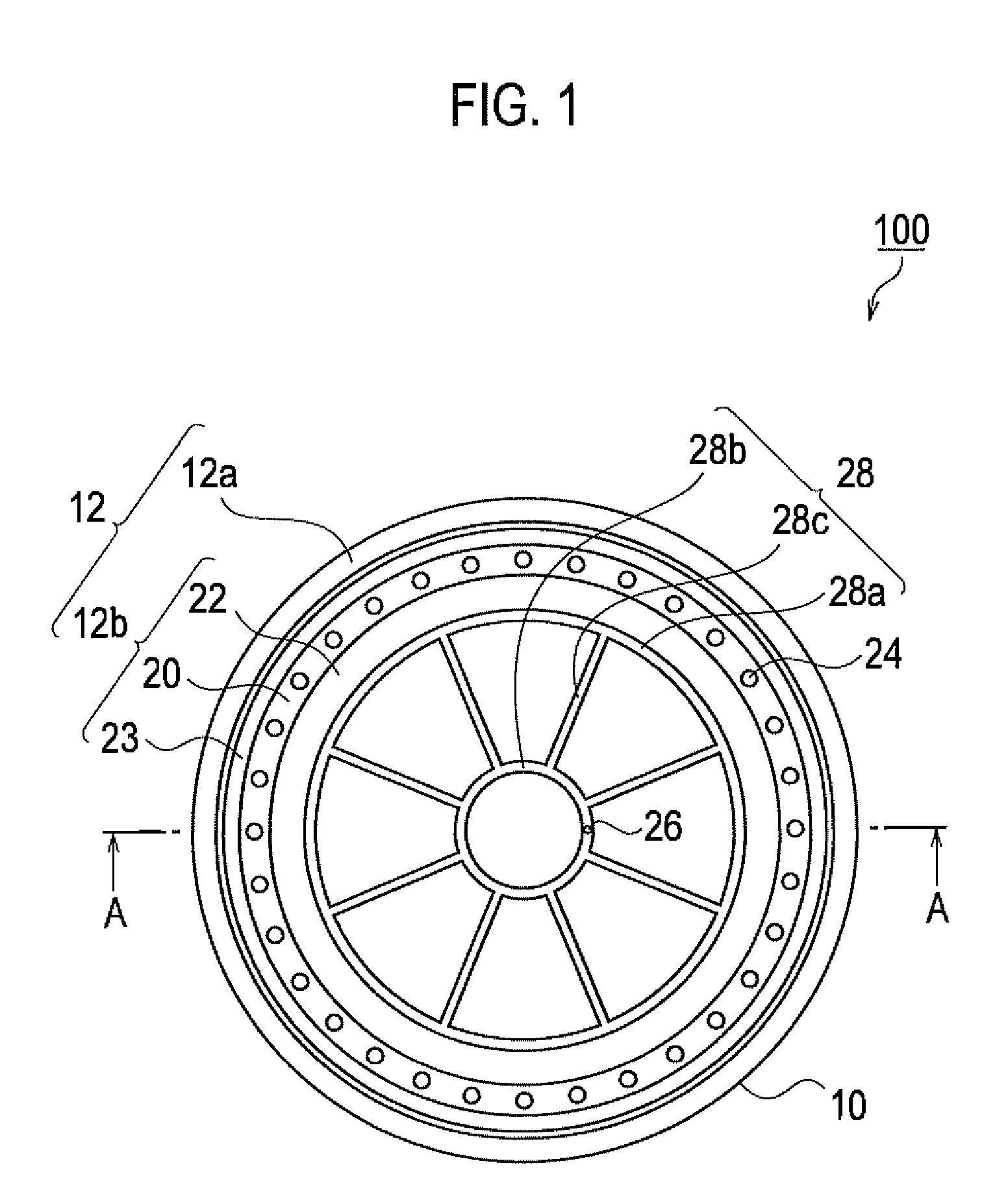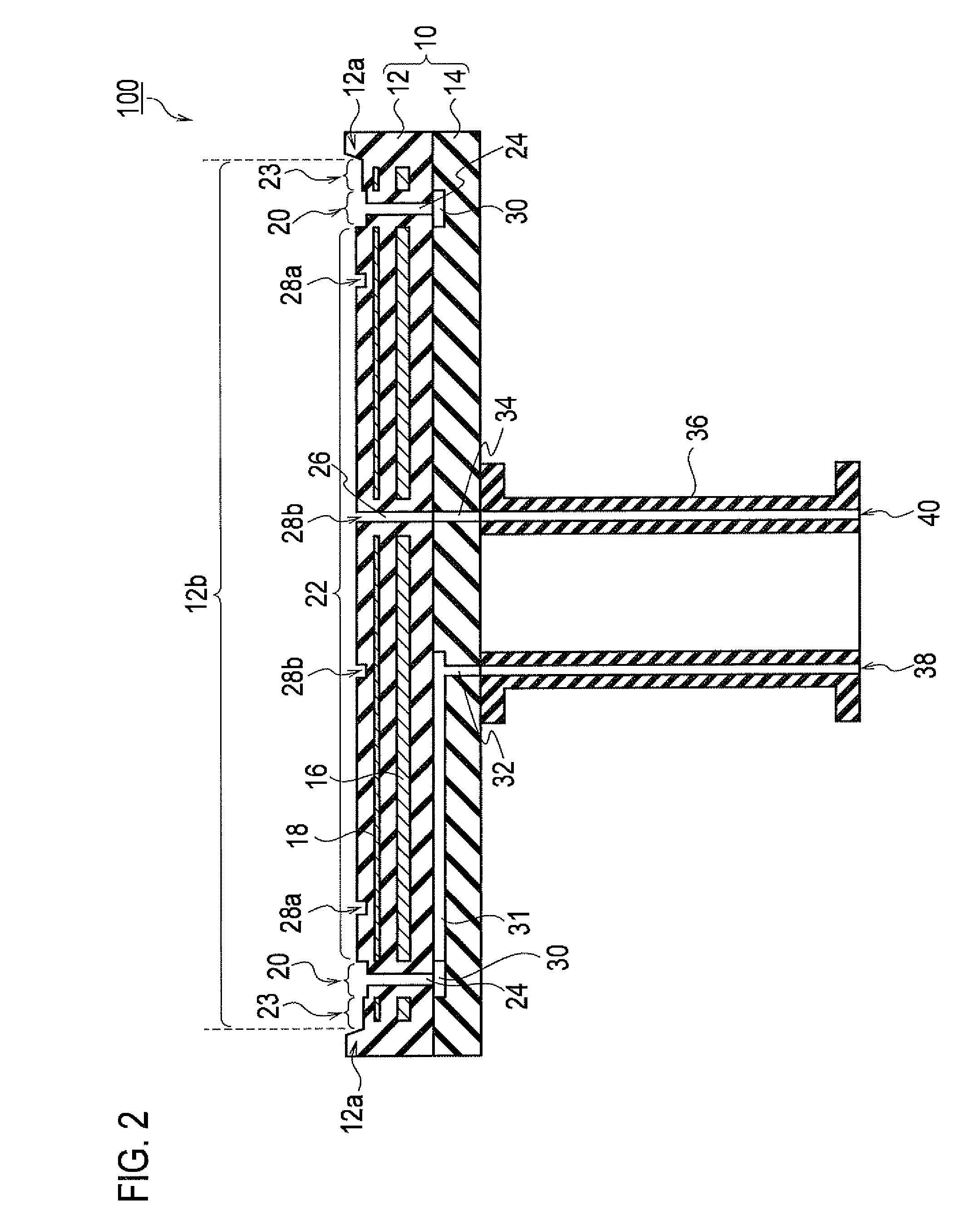Ceramic heater
a ceramic heater and heater plate technology, applied in the direction of coatings, metallic material coating processes, chemical vapor deposition coatings, etc., can solve the problems of deteriorating the quality of the film to be formed on the substrate, non-uniform temperature distribution in the substrate, and forming a dent in the region, so as to improve the temperature uniformity, deteriorating the temperature uniformity, and increasing the amount of purge gas ejected from the vicinity of the purge hole 24
- Summary
- Abstract
- Description
- Claims
- Application Information
AI Technical Summary
Benefits of technology
Problems solved by technology
Method used
Image
Examples
embodiment
[0045](1) Structure of Ceramic Heater
[0046]Hereinafter, a structure of the ceramic heater according to the embodiment of the present invention will be described with reference to the drawings.
[0047](1.1) Schematic Structure of Ceramic Heater
[0048]FIG. 1 is a plan view showing one example of a ceramic heater 100 according to the embodiment the present invention. FIG. 2 is a schematic diagram showing the cross-section of the ceramic heater 100 shown in FIG. 1 taken along the line A-A. As shown in FIGS. 1 and 2, the ceramic heater 100 includes: a plate 10 on which a substrate (unillustrated) is mounted; a shaft 36 configured to support the plate 10; and the like. The plate 10 includes a first base 12 and a second base 14. The upper surface of the second base 14 is bonded to the lower surface of the first base 12. One end of the shaft 36 is bonded to the lower surface of the second base 14. Note that, hereinafter, one end of the shaft 36 refers to one of the end portions of the shaft 36...
modification example 1
[0107]Hereinafter, a ceramic heater 100 according to Modification Example 1 of the embodiment of the present invention will be described.
[0108]In the above-described embodiment of the present invention, the description has been given of the case where the first base 12 has the vacuum chuck groove 28 configured to vacuum-adsorb a substrate onto the mounting surface 12b. However, the present invention is not limited to this. For example, a space larger than the vacuum chuck groove 28 may be formed between the substrate and the mounting surface 12b as a space to be evacuated.
[0109]The structure of the ceramic heater 100 according to Modification Example 1 will be described with reference to FIGS. 6 and 7. FIG. 6 is a plan view showing the ceramic heater 100 according to Modification Example 1. FIG. 7 is a schematic diagram showing the cross-section of the ceramic heater 100 shown in FIG. 6 taken along the line B-B. Hereinafter, description will be mainly given of the difference between...
modification example 2
[0117]Hereinafter, a ceramic heater 100 according to Modification Example 2 of the embodiment of the present invention will be described.
[0118]In the above-described embodiment of the present invention, the description has been given of the case where the vacuum chuck is used to hold a substrate on the mounting surface 12b. However, the present invention is not limited to this. For example, an electrostatic chuck may be used to hold a substrate on the mounting surface 12b.
[0119]The structure of the ceramic heater 100 according to Modification Example 2 will be described with reference to FIGS. 8 and 9. FIG. 8 is a plan view of the ceramic heater 100 according to Modification Example 2. FIG. 9 is a schematic diagram showing the cross-section of the ceramic heater 100 shown in FIG. 8 taken along the line C-C. Hereinafter, description will be mainly given of the difference between the above-described embodiment and Modification Example 2.
[0120]As shown in FIGS. 8 and 9, the first regi...
PUM
| Property | Measurement | Unit |
|---|---|---|
| diameter | aaaaa | aaaaa |
| width | aaaaa | aaaaa |
| width | aaaaa | aaaaa |
Abstract
Description
Claims
Application Information
 Login to View More
Login to View More - R&D
- Intellectual Property
- Life Sciences
- Materials
- Tech Scout
- Unparalleled Data Quality
- Higher Quality Content
- 60% Fewer Hallucinations
Browse by: Latest US Patents, China's latest patents, Technical Efficacy Thesaurus, Application Domain, Technology Topic, Popular Technical Reports.
© 2025 PatSnap. All rights reserved.Legal|Privacy policy|Modern Slavery Act Transparency Statement|Sitemap|About US| Contact US: help@patsnap.com



